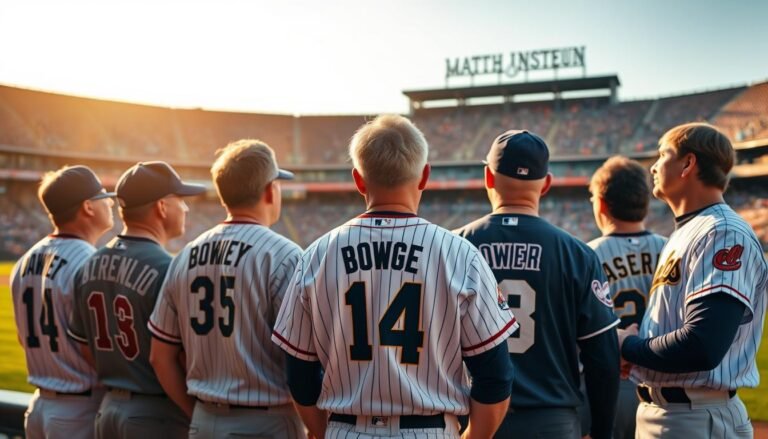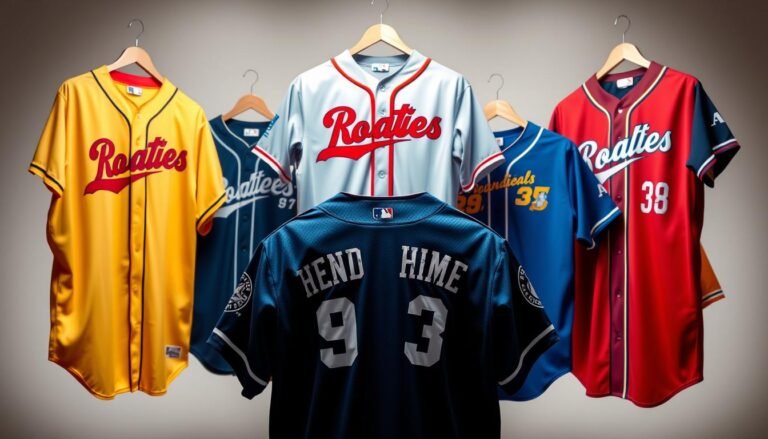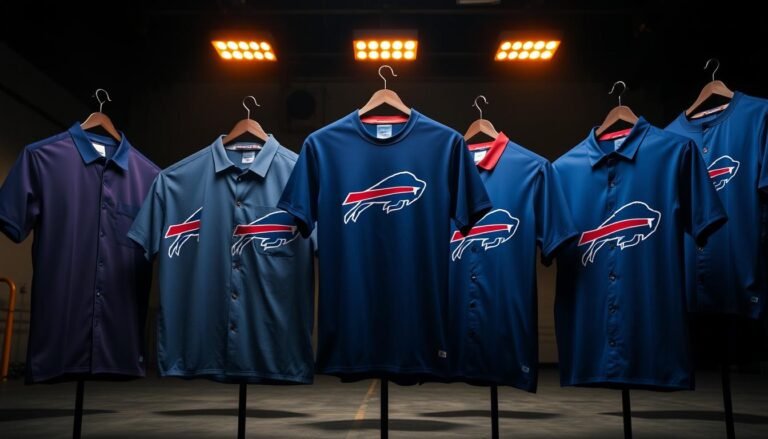The creation of a professional sports team’s uniform is a multifaceted process that involves various stakeholders, from league officials to apparel manufacturers.
Understanding the intricacies of pro team uniform development is essential for appreciating the final product that appears on the field.
This complex journey involves collaboration between teams, league officials, and manufacturers to bring a concept to life.
Key Takeaways
- The jersey design process involves multiple stakeholders.
- Collaboration is key to bringing a concept to life.
- Understanding the design process enhances appreciation for the final product.
- League officials, teams, and manufacturers work together.
- The final product is a result of intricate planning and design.
The Evolution of Sports Jerseys
The evolution of sports jerseys is a fascinating story that reflects technological advancements, changing player needs, and shifting fashion trends. Sports jerseys have come a long way from their humble beginnings, transforming into the sophisticated, high-performance garments we see today.
Historical Significance of Team Uniforms
Team uniforms have long held significant cultural and social meaning, often reflecting local identities and team heritage. The earliest sports jerseys were simple in design, typically made from cotton or wool. These early jerseys were not just functional but also symbolic, representing team unity and identity.
How Jersey Design Has Changed Over Decades
Jersey design has undergone substantial changes, driven by advancements in technology and shifting player needs. Modern jerseys incorporate cutting-edge materials and designs that enhance performance and comfort.
Material Innovations Through the Years
The introduction of synthetic fibers and moisture-wicking technologies has revolutionized jersey design. Modern materials provide athletes with improved comfort and performance.
Style Evolution Across Major Leagues
Different leagues have adopted unique styles, reflecting their distinct histories and cultural influences. For instance, the NBA has seen a trend towards more vibrant and bold designs, while the NFL has maintained a more traditional look.
| League | Typical Jersey Material | Common Design Elements |
|---|---|---|
| NBA | Moisture-wicking polyester | Bold colors, unique typography |
| NFL | Polyester blends | Traditional logos, striped designs |
| MLB | Cotton-poly blends | Classic logos, pinstripes |
The evolution of sports jerseys reflects a blend of technological innovation, cultural expression, and athletic performance. As sports continue to evolve, so too will the jerseys worn by athletes.
Key Stakeholders in the Jersey Design Process
Creating a jersey for a professional sports team is a collaborative effort that involves several key stakeholders. Each of these stakeholders brings their unique insights and requirements to the table, ensuring that the final product is both functional and appealing to fans.
Teams and Franchise Management
Teams and their management play a crucial role in the jersey design process. They provide input on the overall aesthetic and branding of the jersey, ensuring it aligns with the team’s identity and history. Franchise management works closely with designers to incorporate elements that reflect the team’s heritage and values.
League Officials and Branding Guidelines
League officials are responsible for establishing branding guidelines that teams must follow. These guidelines ensure consistency across all teams within the league, maintaining a professional and cohesive look. Designers must adhere to these guidelines when creating new jersey designs, balancing team identity with league-wide branding standards.

Apparel Manufacturers and Designers
Apparel manufacturers and designers are the creative force behind bringing jersey designs to life. They work with teams and league officials to interpret design concepts and produce high-quality jerseys that meet performance and aesthetic standards. Their expertise in materials, technology, and design trends is crucial in creating modern, competitive jerseys.
Players’ Input and Performance Needs
Players’ feedback is invaluable in the jersey design process. They provide insights into the comfort, functionality, and performance of the jersey, ensuring that it meets their needs on the field. Their input can influence design decisions, from the choice of materials to the fit and feel of the jersey.
How Athlete Feedback Shapes Design
Athlete feedback directly impacts the final design of the jersey. By understanding the performance needs and preferences of the players, designers can create jerseys that enhance their performance while also representing the team’s brand effectively. This collaborative approach ensures that the jersey is both visually appealing and functionally superior.
Initial Concept Development
As the foundation of the jersey design process, initial concept development involves a deep dive into brand identity and fan preferences. This critical phase sets the stage for creating a jersey that not only looks great but also resonates with the team’s history and values.
Brand Identity and Team Heritage
The design process begins with a thorough examination of the team’s brand identity and heritage. This includes understanding the team’s history, its values, and the symbolism behind its colors and logos. Designers work closely with team management to capture the essence of the team’s identity, ensuring that the jersey design is a true representation of the team’s spirit.
Market Research and Fan Preferences
Understanding fan preferences is crucial in the initial concept development phase. Market research helps designers gauge fan sentiment, identifying trends and elements that fans love about the current design and what they’d like to see changed. This feedback is invaluable in creating a jersey that fans will be excited to wear.
Competitive Analysis Within the League
A competitive analysis within the league is also conducted to ensure the new design stands out among other teams. This involves analyzing the designs of rival teams, identifying gaps in the market, and finding opportunities to innovate. The goal is to create a design that is both unique and competitive.
Balancing Tradition and Innovation
One of the key challenges in initial concept development is balancing tradition with innovation. Designers must walk a fine line between respecting the team’s heritage and introducing new elements that keep the design fresh and exciting. This balance is crucial in creating a jersey that appeals to both long-time fans and new supporters.
The Jersey Design Process in Pro Sports
From concept to reality, the jersey design process in pro sports involves a series of intricate steps that require careful planning, creativity, and technical expertise. The process begins with establishing clear design objectives and timelines, which serve as the foundation for the entire project.
Establishing Design Objectives and Timeline
The first step in the jersey design process is to define the design objectives, which include understanding the team’s brand identity, fan preferences, and performance requirements. This stage is crucial as it sets the direction for the entire design process. A well-defined timeline ensures that the design is completed on time for production and distribution.
Creative Brainstorming Sessions
Creative brainstorming sessions are a vital part of the jersey design process. These sessions bring together designers, team representatives, and other stakeholders to generate innovative ideas and concepts. Brainstorming allows for the exploration of different themes, colors, and design elements that reflect the team’s identity and appeal to fans.

Preliminary Sketches and Concept Art
Following the brainstorming sessions, designers create preliminary sketches and concept art. This stage involves translating ideas into visual representations. Traditional hand drawings are often used initially, providing a tangible and personal touch to the design process.
From Hand Drawings to Digital Concepts
The transition from hand drawings to digital concepts is a significant step in modern jersey design. Digital tools enable designers to refine their ideas, experiment with different colors and patterns, and create precise designs that can be easily modified and shared. This digital transformation enhances the efficiency and flexibility of the design process.
The jersey design process in pro sports is a collaborative and creative journey that results in a unique and functional product. By understanding the team’s needs and leveraging both traditional and digital design techniques, designers can create jerseys that are both visually appealing and performance-driven.
Design Elements and Considerations
Sports jersey design is an intricate process that balances aesthetics with functionality, incorporating several key elements. The careful consideration of these elements ensures a jersey that is both visually appealing and meaningful to fans and players alike.
Color Theory and Team Color Palettes
The selection of colors for a sports jersey is a critical design element that reflects the team’s identity and heritage. Color theory plays a significant role in this process, as different colors can evoke various emotions and reactions from fans. Teams often choose color palettes that are consistent with their brand identity, while also ensuring that the colors are visually appealing when worn on the field.
Typography and Number Styles
Typography and number styles are other crucial design elements that contribute to the overall look of a jersey. The choice of font for player names and numbers must be legible, consistent with the team’s brand, and compliant with league regulations. Designers often experiment with different typography to find the perfect balance between style and readability.
Logos, Emblems, and Placement
Logos and emblems are integral to a team’s brand identity and are often prominently featured on jerseys. The placement of these elements requires careful consideration to ensure they are displayed effectively without overwhelming the overall design. Designers must balance the size and positioning of logos with other design elements like numbers and typography.
Cultural and Historical References
Incorporating cultural and historical references into jersey design can add depth and meaning to a team’s brand. This can include nods to the team’s history, the city or region they represent, or significant cultural icons.
Incorporating City and Team Heritage
Many teams choose to incorporate elements that reflect their city or team’s heritage into their jersey designs. This can involve using local colors, motifs, or historical references that resonate with fans and honor the team’s legacy.
By carefully balancing these design elements, teams can create jerseys that are not only visually appealing but also rich in meaning and heritage. The jersey design process is a complex but rewarding endeavor that requires collaboration between designers, team management, and league officials to produce a final product that meets the expectations of fans and players alike.
Special Jersey Categories and Variations
Professional sports teams frequently unveil diverse jersey categories, encompassing home, away, and alternate designs, alongside throwback and special event jerseys. These variations offer opportunities for creative expression and fan engagement.
Home, Away, and Alternate Jerseys
Teams typically have home and away jerseys, with home jerseys often being more vibrant and away jerseys being more subdued. Alternate jerseys provide additional design flexibility, allowing teams to showcase unique designs or colors.
Throwback and Retro Designs
Throwback jerseys pay homage to a team’s history, featuring classic designs or logos from past decades. These jerseys are often released as limited editions, creating a buzz among fans.
Special Event and Commemorative Jerseys
Special event jerseys are designed for specific occasions, such as holiday games or charity events. Commemorative jerseys honor significant events or milestones in a team’s history.
City Edition and Heritage Uniforms
City Edition jerseys celebrate the culture and identity of the city where the team is based. Heritage Uniforms are designed to honor a team’s history and legacy, often featuring classic designs or logos.
| Jersey Category | Description | Design Considerations |
|---|---|---|
| Home Jerseys | Primary jerseys worn during home games | Often feature vibrant colors and primary logos |
| Away Jerseys | Jerseys worn during away games | Typically more subdued, with less vibrant colors |
| Alternate Jerseys | Additional jersey designs for variety | Allow for unique designs, colors, or themes |
| Throwback Jerseys | Jerseys featuring classic designs or logos | Pay homage to a team’s history and legacy |
The diverse range of jersey categories and variations enables teams to connect with fans in different ways, while also showcasing their unique identity and heritage.
Technical Aspects of Jersey Production
The production of sports jerseys involves a meticulous process that considers various technical aspects to ensure both performance and comfort.
Fabric Selection and Performance Technology
The choice of fabric is crucial in determining the overall performance of the jersey. Modern sports jerseys often utilize advanced materials that provide lightweight, breathable, and moisture-wicking properties. For instance, Nike’s Dri-FIT and Adidas’s Climalite technologies are designed to keep athletes cool and dry.
Moisture Management and Breathability
Effective moisture management is key to maintaining athlete comfort during intense physical activities. Jerseys are designed to draw sweat away from the skin and allow for quick evaporation, thereby enhancing breathability and reducing the risk of overheating.
Durability and Maintenance Requirements
Durability is another critical factor in jersey production. Manufacturers use various techniques, such as reinforced stitching and high-quality materials, to ensure that jerseys can withstand the rigors of frequent use and washing. Easy maintenance is also a consideration, with many jerseys being machine washable.
Sustainability Considerations in Modern Production
In recent years, there has been a growing emphasis on sustainability in sports apparel production. Many manufacturers are now incorporating eco-friendly materials and practices into their production processes. For example, some companies are using recycled polyester made from plastic bottles to reduce environmental impact.
| Feature | Description | Benefit |
|---|---|---|
| Moisture-wicking fabric | Draws sweat away from the skin | Keeps athletes cool and dry |
| Breathable design | Allows for airflow | Reduces overheating |
| Durable construction | Reinforced stitching and quality materials | Withstands frequent use and washing |
As the sports apparel industry continues to evolve, the integration of sustainable practices and advanced technologies will remain crucial in the production of high-quality sports jerseys.
“The future of sports apparel lies in its ability to merge performance with sustainability.”
Digital Prototyping and Visualization
The use of digital tools has streamlined the jersey design process, enabling teams to visualize and refine their designs more effectively. This advancement in technology has significantly impacted pro team uniform development, allowing for more precise and detailed designs.
3D Modeling and Digital Rendering
Digital prototyping involves creating 3D models of jersey designs, which can be manipulated and viewed from various angles. This process facilitates the identification of potential design flaws early on, reducing the need for physical prototypes and speeding up the overall jersey design process.
Virtual Try-Ons and Game Simulations
Virtual try-ons enable players to see how the jersey will look on them without the need for a physical sample. Additionally, game simulations can be conducted to test the performance of the jersey under various conditions, further enhancing the design.
How Technology Has Streamlined the Design Process
The integration of digital prototyping and visualization has not only improved the accuracy of design visualization but has also reduced the time and cost associated with the traditional design process. This technological advancement is revolutionizing the way teams approach pro team uniform development.
| Technology | Benefit | Impact on Design Process |
|---|---|---|
| 3D Modeling | Detailed design visualization | Reduces physical prototypes |
| Virtual Try-Ons | Player feedback without physical samples | Speeds up design refinement |
| Game Simulations | Performance testing under game conditions | Enhances design functionality |
Physical Prototyping and Testing
Physical prototyping and testing are pivotal in ensuring that sports jerseys meet both performance and aesthetic standards. This phase is crucial in the jersey design process, as it translates digital designs into tangible products that are then tested under real game conditions.
Sample Production Process
The first step in physical prototyping involves producing sample jerseys. Manufacturers use the finalized design concepts to create initial prototypes, often using a combination of traditional craftsmanship and modern technology. These samples are typically produced in various sizes to accommodate different players.
Player Testing in Game-Like Conditions
Once the sample jerseys are produced, they are put through rigorous testing by athletes under game-like conditions. This testing phase is critical to understanding how the jersey performs in terms of comfort, mobility, and durability. Players provide valuable feedback on aspects such as fabric feel, fit, and overall performance.
Adjustments Based on Athletic Performance
Feedback from player testing is then used to make necessary adjustments to the jersey design. This might involve tweaking the fabric composition, adjusting the fit, or modifying design elements to enhance performance. The goal is to ensure that the jersey not only looks great but also meets the high standards of professional athletes.
Iterative Design Refinements
The process of testing and refinement is iterative. Designers and manufacturers work closely with players and coaches to refine the jersey until it meets all the required standards. This collaborative process ensures that the final product is both functional and visually appealing, embodying the team’s identity while enhancing player performance.
Manufacturing and Approval Process
The journey of a sports jersey from design to the field involves several critical steps, ensuring that the final product meets the expectations of both the team and the league.
Team and League Approval Stages
Before mass production begins, the jersey design must be approved by both the team management and league officials. This stage is crucial as it ensures that the jersey complies with league regulations and aligns with the team’s brand identity.
Mass Production Preparation
Once the design is approved, preparations for mass production commence. This involves selecting the appropriate materials, manufacturing techniques, and ensuring that the production process is scalable.
Quality Control Measures
To guarantee the quality of the jerseys, several quality control measures are implemented. These include:
- Inspecting materials for durability and comfort
- Testing the jerseys for colorfastness and shrinkage
- Ensuring that the jerseys meet the performance requirements of the athletes
From Factory to Field Timeline
The timeline from production to delivery is critical. Efficient logistics and supply chain management ensure that jerseys reach the teams on time.
Licensing and Authentication Protocols
To combat counterfeiting, jerseys undergo strict licensing and authentication protocols. This includes holograms, unique serial numbers, and other anti-counterfeiting measures.
| Stage | Description | Timeline |
|---|---|---|
| Design Approval | Team and league approval | 2 weeks |
| Mass Production | Preparation and production | 6 weeks |
| Quality Control | Inspection and testing | 3 weeks |
| Delivery | Shipping to teams | 2 weeks |
Conclusion: The Future of Jersey Design in Professional Sports
The jersey design process in professional sports is a complex, multi-faceted endeavor that involves various stakeholders, from team management to apparel manufacturers. As discussed, the evolution of sports jerseys has been shaped by historical significance, technological advancements, and changing player needs.
Looking ahead, the future of jersey design will be influenced by emerging trends, such as sustainable materials and digital printing technologies. The ongoing importance of balancing performance, aesthetics, and fan engagement will continue to drive innovation in pro team uniform development. As sports jerseys continue to play a crucial role in team identity and fan culture, understanding how sports jerseys are made will remain essential for teams, leagues, and manufacturers.
By embracing new technologies and design approaches, the sports industry can create jerseys that not only meet the needs of athletes but also resonate with fans worldwide. As the jersey design process continues to evolve, it will be exciting to see how pro team uniform development shapes the future of professional sports.





